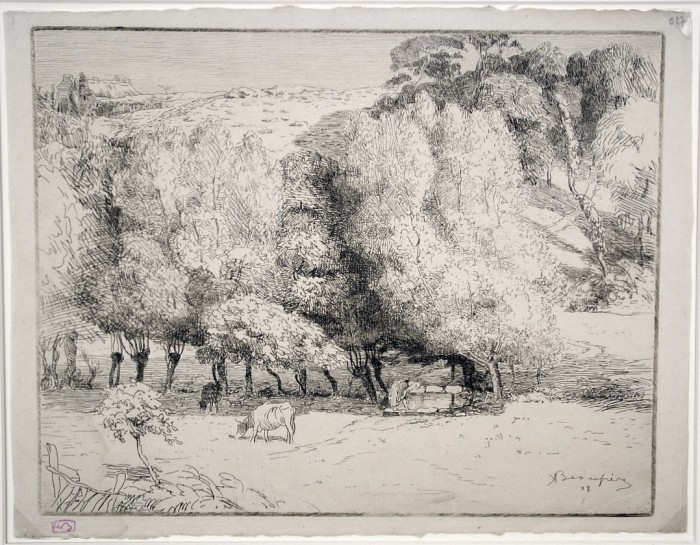Lavoir de Kervino

Adolphe Beaufrere (1876-1960), Lavoir de Kervino, 1908, etching, with the Beaufrere red estate stamp lower left recto [also signed and dated in the plate lower right]. References: Morane 08-02, Laran 35. Printed in a dark brown ink, on a thin wove Japan paper. In very good condition, unobtrusive water stain lower left, crease lower right corner, with margins, 9 1/2 x 12, the sheet 10 1/4 x 13 1/4 inches.
Provenance: acquired directly from Jean-Noel Beaufrere, the artist’s son.
A fine impression of this very rare print.
This impression is probably a first state working proof, before some foliage was added lower right, shading lines lower left, and clouds in the sky (as illustrated in Morane). Morane notes that there were only 6 proofs of the state he illustrated (presumably the second state); then the plate was cut down radically to about one-third of its width, leaving only a strange looking vertical print of the trees and lavoir (where a woman appears to be washing her feet); then cut a bit more for a small edition of 10.
Beaufrere was born at Quimperle, in Brittany, and though he traveled widely he re-connected with this area throughout his life. As a teenager he decided that he wanted to become an artist and he traveled to Paris where, shortly after his arrival, he encountered the eminent Gustave Moreau, who took him on as a student. Moreau encouraged him to study old master prints, especially the prints of Rembrandt and Durer, which were available in the Cabinet des Estampes in Paris – this was to be critical in his development. He was also influenced by the stirrings of modernism in Paris at the time, as well as the Japanese woodcut tradition and the French frenzy with Japonisme.
Beaufrere began printmaking near the end of his formal training; he made a number of woodcuts, but soon focused more on etching and engraving, as well as painting (curiously, one of his printmaking teachers at that time was the Canadian etcher Donald Shaw MacLaughlan). He began showing his prints, with some success, but after his marriage in 1905 his new wife convinced him to move out of Paris and back to Brittany, a move having a mixed effect on his career – contacts with other artists became fewer, but he did maintain gallery relationships, and the French countryside and it’s inhabitants would provide a continuing source of inspiration – as illustrated in Lavoir de Kervino.